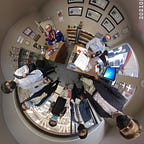There’s A Little Bit Of Ames In Every Launch
This winter break I was given the opportunity to interview and tour the Johnson Space Center in Houston, featuring some of their best collections of astronomical works and its fascinating physiological research at the Ames Research Center.
Aerospace Medicine arose to not just focus on operational health in space travel, but also as an educational division guiding thousands of ascending junior researchers and aspiring physicians. Swiftly, in a dreamlike manner, I boarded my flight to the Johnson Space Center.
This process felt as if time was immaterial — a curious, conscious, mixture of thrilling and distressing emotions. Seemingly, it was self-consciousness or a persistent internalized fear of competence accumulated under distinguished researchers and medical professionals. Upon stepping onto the facility, the change in environment emphasized these sentiments — as if I was standing in a spotlight of a performance. Intrigued by the fascinating shuttle replica Independence mounted on the historical NASA 905 shuttle carrier aircraft, I acknowledged my diligence to have this opportunity and proceeded into the center.
Since 1939, the Ames Research Center has executed biology experiments at various locations including the International Space Station, the Moon, and Mars. There is a profound, almost mystifying presence exploring our Earth, the solar system, and beyond — addressing enthralling questions regarding the origins of life, life’s potential to survive, and thrive in space and other worlds.
In fact, Ames Research Center Director Eugene Tu leads civil servants and contractors in providing research, development in the aeronautics, and space mission of NASA and features the biology and space technology research mission in “two driving aims.”
“We are combining biology and space technology with two driving aims: detecting life off our planet, and understanding how Earth life is different in space, so healthy humans can explore from the Moon to Mars.”
For decades, following initial experiments of aerodynamics and autonomous vehicles, the Ames Research Center enacted programs to build a foundation for a future for drones to become a part, amidst our daily lives.
Further, the promotion of improved understanding of health problems for humans on Earth shares a distinct pursuit to Ames’ researchers. For instance, the detrimental effects of aging, and treatments including osteoporosis. These advanced treatments contribute to the essence of the “early-stage” research center concentrating on explorations and answering questions of the unknown.
Hence, this introduces the question. With space exploration and addressing health problems being the Ames Research Center’s primary goals, what are some potential experiments that we can anticipate?
My research presents the clinical breath analysis of metabolites and biomarker molecules that are present in our respiratory system — sharing many relationships with physiological states and health assessment.
Perhaps, we don’t answer all these questions in our lifetime. However, these opportunities are available for the younger generation, we’ll assuredly find the answers.
